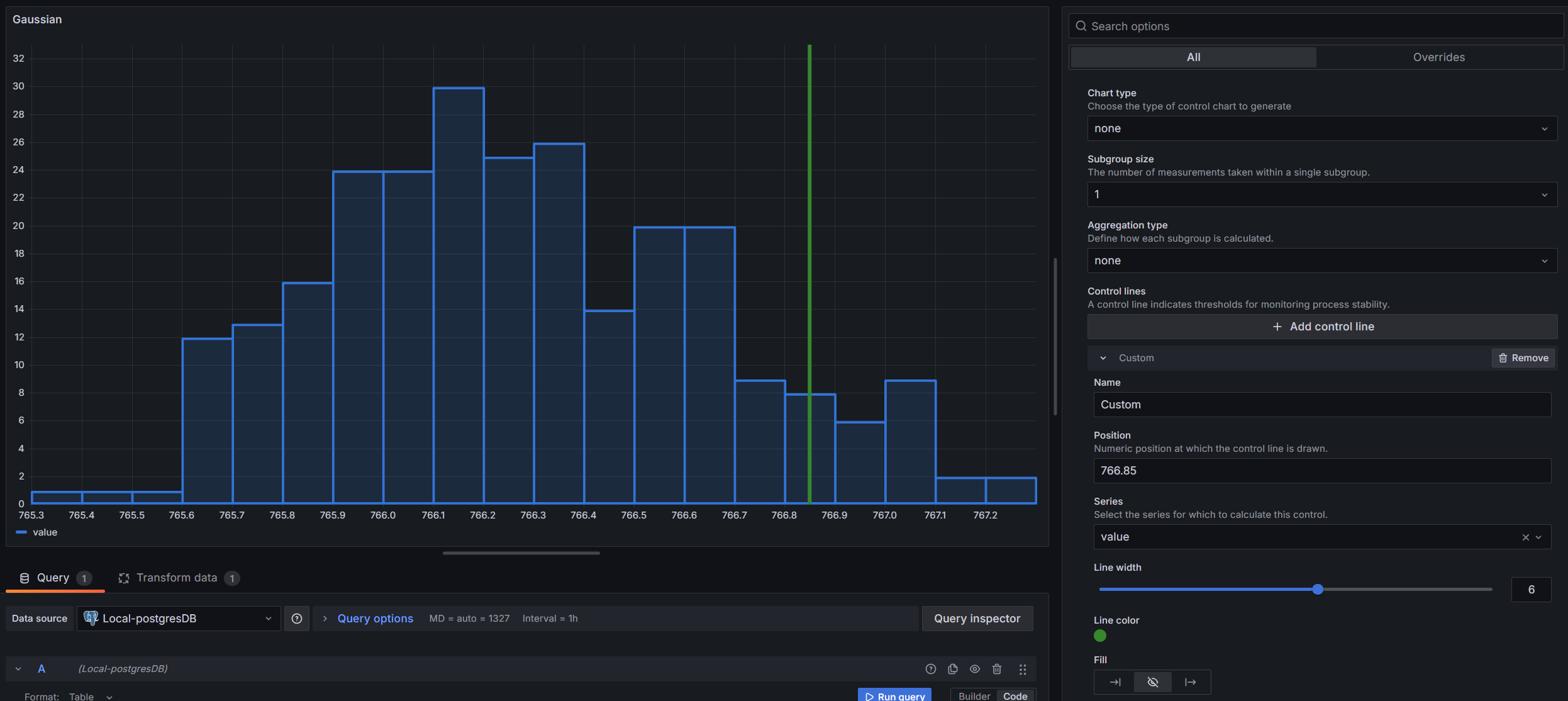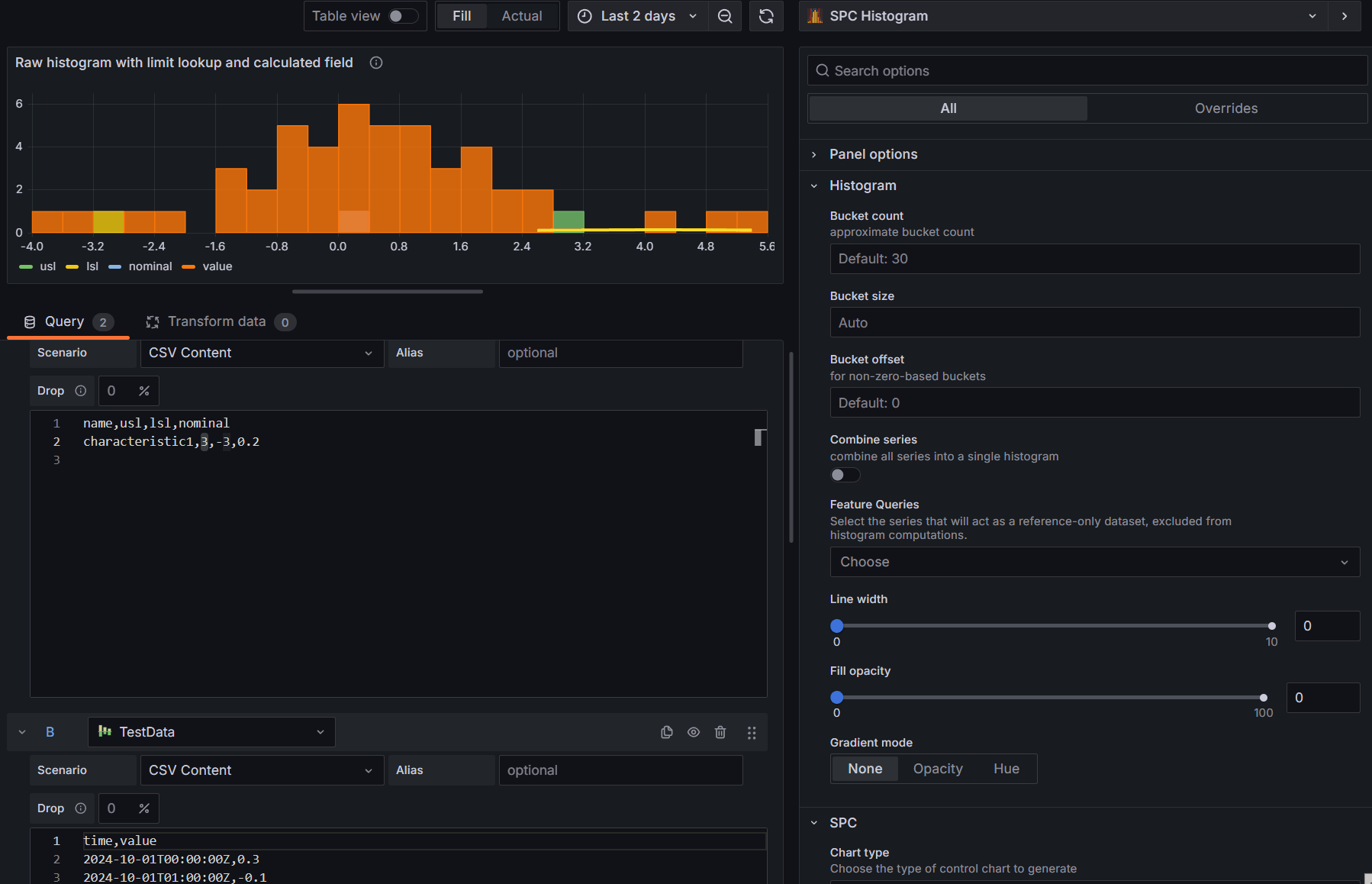Control Chart
SPC histogram calculates multiple control chart types from time series data and displays them as histograms. It offers various chart types including XmR, Xbar-R, and Xbar-S, along with customizable control lines and aggregation options, enabling comprehensive process monitoring and analysis.
Control Lines
A control line is a vertical line that shows a limit or threshold. You can add custom control line values or use ones calculated from the dataset.

Calculated
- LCL - Lower Control Limit, marking the lower boundary of the control chart
- UCL - Upper Control Limit, marking the upper boundary of the control chart
- Min - Minimum of the sample values
- Max - Maximum of the sample values
- Mean - Average of all the sample values
- Range - Difference between the highest and lowest sample values
Custom
In the SPC histogram panel, there are two types of custom lines you can add:
- Static Value - Where you manually input a value for the control line.
- Feature series - Where the line's value is dynamically pulled from your feature dataset. This enhances the flexibility of your histograms by integrating limits or custom calculations dynamically from your dataset.
How to Add a Custom Control Line with field lookup

-
Setup Your Queries:
- Create at least two queries in your data source:
- One query for the time series data you wish to visualize in the histogram.
- Another query for the control limits or any reference values.
- Create at least two queries in your data source:
-
Configure the Histogram:
- By default, the histogram will attempt to calculate using all numeric values from all queries. To exclude a query meant only for reference (like control limits) from these calculations:
- Navigate to Editor > Histogram > Feature Queries.
- Select the query that contains your control limits or reference data.
- By default, the histogram will attempt to calculate using all numeric values from all queries. To exclude a query meant only for reference (like control limits) from these calculations:
-
Add a Control Line:
- Click on Add Control Line and select Custom.
- In the Series dropdown, choose the query that contains your reference or control limit data.
-
Set Position:
- Under Position Input, select Series.
- A Position dropdown will appear, displaying all available numeric fields from the selected series. Choose the field that represents your control limit.
-
Visualization:
- Once a numeric field is selected, it will appear as a vertical line on the histogram, representing the control limit or any other reference value.
If the selected field from your series returns more than one value, the histogram will use the last value for the control line.
Set up your reference query in the Feature Queries section. This prevents it from affecting the main data calculations for the histogram.
Visualization
You can change how a control line looks:
- Name - Display name of the control line
- Position - X-axis position where the control line is drawn
- Series - Select the series for which to calculate the control (if you have more than one)
- Line width - Line thickness from 0 to 10
- Color
- Fill - Left fill, no fill, or right fill
- Fill Opacity
Aggregation
When the Chart type is set to none, you can choose an Aggregation Type. This option lets you create new data series from the raw time series values. The available types of aggregation depend on the Subgroup Size you pick.
For example, if you select a Subgroup Size of 5 and choose Mean as the aggregation type, the raw data will be split into groups of 5. Then, the average of each group will be calculated. The resulting series will be used to create the histogram.
Subgroup size = 1
- None
- Moving range
Subgroup size > 1
- Mean
- Range
- Standard Deviation
Dashboard Variable
The SPC Histogram feature includes built-in support for a dashboard variable called subgroupSize. This allows you to control the subgroup size for multiple instances of an SPC Histogram panel using a single dashboard variable. To use this functionality, simply create a dashboard variable named subgroupSize.

Chart Types
XmR Control Chart
The XmR Control Chart (also called Shewhart's Control Chart or I-MR) tracks process variability based on samples taken over time. It consists of two charts: the individual (X) chart and the moving range (mR) chart. This chart is useful when it's hard to use rational subgroups, such as in automated processes.
Individual (X) Chart
 The individual chart shows each data point over time, helping analyze central location. It reveals whether the process centers around a mean value.
The individual chart shows each data point over time, helping analyze central location. It reveals whether the process centers around a mean value.
Moving Range (mR) Chart
 The moving range chart displays the difference between consecutive readings, showing process variability. The chart's average and upper control limit (UCL) help spot unusual patterns or shifts in the data.
The moving range chart displays the difference between consecutive readings, showing process variability. The chart's average and upper control limit (UCL) help spot unusual patterns or shifts in the data.
Xbar-R Control Chart
The Xbar-R Control Chart is used when you have subgroups of data. It consists of two charts: the X-bar chart and the R-bar chart. This chart is useful for processes where you can collect samples in small subgroups.
X-bar Chart for Xbar-R
 The X-bar chart plots the average (mean) of each subgroup over time. It helps monitor the central tendency of the process. The control limits on this chart are based on the average range of the subgroups.
The X-bar chart plots the average (mean) of each subgroup over time. It helps monitor the central tendency of the process. The control limits on this chart are based on the average range of the subgroups.
R-bar Chart for Xbar-R
 The R-bar chart plots the range of each subgroup over time. It helps monitor the variability within the subgroups. The control limits on this chart are based on the average range of all subgroups.
The R-bar chart plots the range of each subgroup over time. It helps monitor the variability within the subgroups. The control limits on this chart are based on the average range of all subgroups.
Xbar-S Control Chart
The Xbar-S Control Chart is similar to the Xbar-R chart but uses standard deviation instead of range to measure variability. It's often preferred for larger subgroup sizes (typically more than 10).
X-bar Chart for Xbar-S
 This chart is identical to the X-bar chart in the Xbar-R system. It plots the average of each subgroup over time. However, the control limits are calculated using the average standard deviation instead of the average range.
This chart is identical to the X-bar chart in the Xbar-R system. It plots the average of each subgroup over time. However, the control limits are calculated using the average standard deviation instead of the average range.
S-bar Chart for Xbar-S
 The S-bar chart plots the standard deviation of each subgroup over time. It helps monitor the variability within the subgroups. The control limits on this chart are based on the average standard deviation of all subgroups.
The S-bar chart plots the standard deviation of each subgroup over time. It helps monitor the variability within the subgroups. The control limits on this chart are based on the average standard deviation of all subgroups.
Using Xbar-S charts instead of Xbar-R charts can provide more sensitive detection of changes in process variation, especially for larger subgroup sizes.